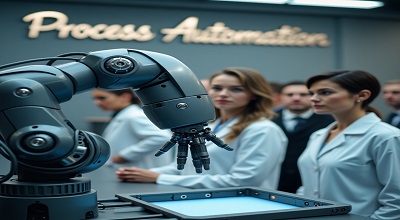Process Automation
Process Automation: In today’s fast-paced business environment, minimizing errors is crucial for efficiency, productivity, and customer satisfaction. Human errors, whether due to fatigue, oversight, or lack of training, can lead to costly mistakes. Process automation has emerged as a powerful solution to mitigate these risks by streamlining workflows and reducing manual intervention.
At ZoomDoors.com, we explore how automation technologies are transforming industries by minimizing human errors, enhancing accuracy, and improving operational efficiency. This comprehensive guide delves into the latest trends, benefits, and real-world applications of automation in error reduction
Understanding Human Errors in Business Processes
What Are Human Errors?
Human errors refer to unintentional mistakes made by employees during task execution. These can range from data entry inaccuracies to procedural lapses, often leading to inefficiencies or financial losses.
Common Causes of Human Errors
- Fatigue & Burnout – Overworked employees are more prone to mistakes.
- Lack of Training – Insufficient knowledge leads to incorrect execution.
- Manual Repetitive Tasks – Monotonous work increases oversight risks.
- Cognitive Overload – Handling too much information at once causes errors.
Impact of Human Errors on Businesses
- Financial losses due to incorrect transactions or rework.
- Compliance violations leading to legal penalties.
- Damaged reputation due to customer dissatisfaction.
What Is Process Automation?
Definition of Process Automation
Process automation involves using technology to perform repetitive tasks without human intervention, ensuring speed, accuracy, and efficiency.
Types of Automation Technologies
- Robotic Process Automation (RPA) – Bots mimic human actions in digital tasks.
- AI & Machine Learning – Smart algorithms detect and prevent anomalies.
- Business Process Automation (BPA) – End-to-end workflow optimization.
Industries Benefiting from Automation
- Healthcare – Automated diagnostics & patient management.
- Banking – Fraud detection & loan processing.
- Manufacturing – Quality checks & inventory management.
How Process Automation Reduces Human Errors?
Eliminating Manual Data Entry Mistakes
Automated data capture tools (OCR, AI) extract and input data with near-perfect accuracy.
Standardizing Workflows for Consistency
Predefined rules ensure every task follows the same error-free process.
Reducing Fatigue-Related Errors
Automation handles repetitive tasks, allowing employees to focus on strategic work.
Enhancing Compliance and Accuracy
Automated audits and checks ensure regulatory adherence without human oversight.
Key Automation Tools for Error Reduction
Robotic Process Automation (RPA)
- Automates rule-based tasks like invoice processing.
- Reduces errors in payroll, HR, and customer onboarding.
AI & Machine Learning
- Detects anomalies in real-time (e.g., fraud in banking).
- Predictive maintenance in manufacturing prevents costly breakdowns.
Business Process Management (BPM) Software
- Streamlines approvals and document workflows.
- Ensures compliance with automated tracking.
Real-World Examples of Automation Reducing Errors
Healthcare: Automated Patient Records
- EHR systems reduce misdiagnosis and prescription errors.
Finance: Fraud Detection & Transaction Accuracy
- AI flags suspicious transactions instantly.
Manufacturing: Quality Control Automation
- Computer vision detects defects faster than humans.
Challenges in Implementing Automation
High Initial Investment Costs
- ROI takes time, but long-term savings justify expenses.
Employee Resistance to Change
- Proper training and change management ease transitions.
Future Trends in Automation for Error Prevention
AI-Driven Predictive Error Detection
- Systems predict mistakes before they occur.
Hyperautomation & IPA
- Combines RPA, AI, and BPM for end-to-end automation.
Best Practices for Implementing Automation
- Conduct a Process Audit – Identify error-prone tasks.
- Choose the Right Tools – Match automation to business needs.
- Train Employees – Ensure smooth adoption.
Conclusion
Process automation is a game-changer in reducing human errors, improving efficiency, and cutting costs. By leveraging RPA, AI, and BPM, businesses can achieve higher accuracy and productivity.
At ZoomDoors.com, we help businesses adopt automation for seamless, error-free operations. Stay ahead by embracing the latest automation trends!
FAQs on Process Automation & Human Error Reduction
Q1: How does automation reduce human errors?
Automation eliminates manual tasks, standardizes workflows, and ensures consistent accuracy.
Q2: Which industries benefit most from automation?
Healthcare, finance, manufacturing, and customer service see significant error reduction.
Q3: What is the difference between RPA and AI automation?
RPA follows predefined rules, while AI learns and adapts to new data patterns.
Q4: Can small businesses afford process automation?
Yes, scalable solutions like cloud-based RPA make automation affordable for SMEs.
Q5: How long does it take to implement automation?
Depending on complexity, implementation can take weeks to months with proper planning.

